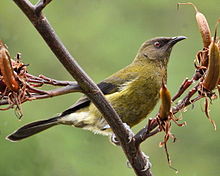
Back نيوزيلندا بيلبيرد ARZ Anthornis melanura AST Proklano (Anthornis) AVK Мёдасмок-званочак Byelorussian Мёдасмок-званочак BE-X-OLD Anthornis melanura Breton Menjamel de Nova Zelanda Catalan Anthornis melanura CEB Medosavka novozélandská Czech Aderyn cloch Seland Newydd Welsh
| New Zealand bellbird | |
|---|---|

| |
| New Zealand bellbird (male) | |
| Scientific classification | |
| Domain: | Eukaryota |
| Kingdom: | Animalia |
| Phylum: | Chordata |
| Class: | Aves |
| Order: | Passeriformes |
| Family: | Meliphagidae |
| Genus: | Anthornis |
| Species: | A. melanura
|
| Binomial name | |
| Anthornis melanura (Sparrman, 1786)
| |
| Synonyms[2] | |
|
List
| |
The New Zealand bellbird (Anthornis melanura), also known by its te reo Māori names korimako, makomako or kōmako, is a medium-sized species of honeyeater endemic to New Zealand. It is the only living member of the genus Anthornis, as the Chatham bellbird went extinct in the early 20th century. The bellbird's closest living relative is the only other New Zealand honeyeater, the tūī (Prosthemadera novaeseelandiae). The bellbird forms a significant component of the famed New Zealand dawn chorus of birdsong, which was much noted by early European settlers. Exceptional singing abilities were already noted by Captain Cook, who described its song as "like small bells most exquisitely tuned".[3]
Bellbirds measure about 17–20 cm in length, with females weighing approximately 25 g and males 33 g. Males are mostly olive-green with paler underparts, and bluish-black wings and tail. Females are paler and browner. Similar to other honeyeaters, the bellbird has a brush-like tongue that enables effective feeding on nectar from deep flowers. The species is common across much of New Zealand, its offshore islands, and the Auckland Islands, but it is scarce north of Waikato and across the Canterbury Plains and Central Otago. Its habitat includes both native and exotic forests and scrublands, and it is commonly found in parks and gardens.
Bellbirds feed on nectar, fruit, honeydew, and insects. During the breeding season, they become highly territorial and aggressively defend their territory against intruders. Bellbirds form monogamous pairs with long-lasting bonds that can span many years. Females typically lay around 3–4 eggs and incubate them for about 13–15 days. Fledging occurs approximately 19 days after hatching. Bellbirds have modified their ninth primaries, allowing them to produce specific whirring sounds in flight that they utilize during courtship and territorial defence. The bellbird is regarded as taonga by the Māori, who traditionally valued it for both its meat and its melodious singing abilities.
- ^ BirdLife International (2017). "Anthornis melanura". IUCN Red List of Threatened Species. 2017: e.T22704447A110985953. doi:10.2305/IUCN.UK.2017-1.RLTS.T22704447A110985953.en. Retrieved 13 November 2021.
- ^ Cite error: The named reference
Checklistwas invoked but never defined (see the help page). - ^ Cook, James (1890). The Three Famous Voyages of Captain James Cook Round the World. London: Ward, Locke and Company. p. 165.
© MMXXIII Rich X Search. We shall prevail. All rights reserved. Rich X Search
